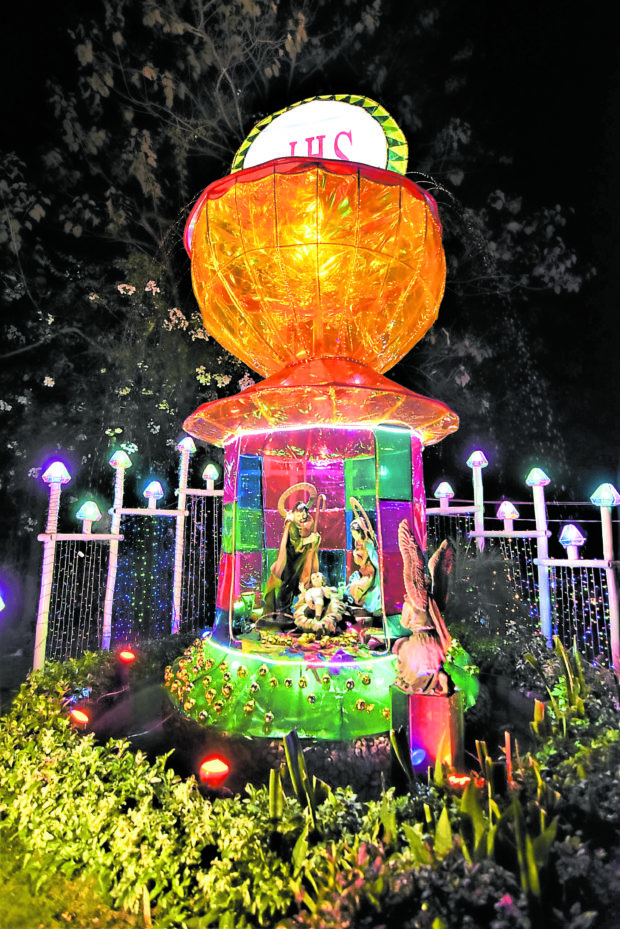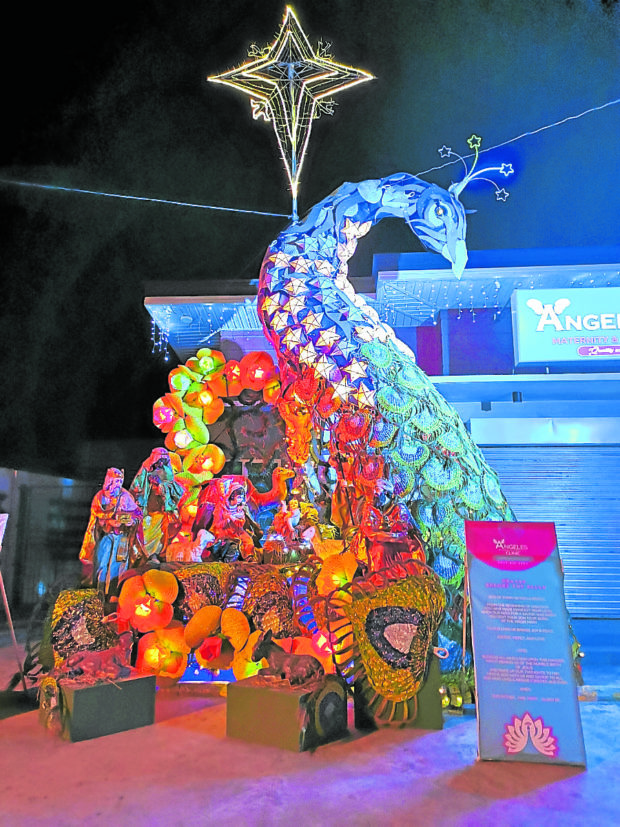Tarlac’s ‘Belenismo’ shows power of sharing amid pandemic

DIVINE SCENE: A golden locket reveals the Holy Family in the “belen” (Nativity diorama) produced by soldiers belonging to the Northern Luzon Command (Nolcom) of the Armed Forces of the Philippines in Tarlac City for this year’s “Belenismo.” Nolcom is a hall of famer for the competition’s grand nonmunicipal category. —WILLIE LOMIBAO
TARLAC CITY, Tarlac, Philippines — As COVID-19 infections subside, residents of Tarlac province have been flocking around 55 “belen” (Nativity dioramas) that literally brighten their quarantine-weary towns.
For the past 14 years, towns, villages, civic organizations, and even the military have been setting up their dioramas along stretches of Tarlac’s roads for the annual “Belenismo” (Spanish for the Nativity scene) to remind people that Christmas is about the birth of Jesus Christ.
The event, which is part competition, part spiritual advocacy, was conceived in 2007 by the late Fr. Alex Bautista, a licensed architect of the Diocese of Tarlac. Belenismo has been staged annually with the help of the Tarlac Convention and Visitors Bureau, the provincial government and the Tarlac Heritage Foundation.
One of this year’s attractions is a “floating” belen, which its makers say symbolizes the power of sharing that sustained Filipinos in the second year of the pandemic.
The diorama features mannequins representing the Holy Family—baby Jesus, Joseph and Mary—clad in white as they ride a “balsa” (raft) to meet the Three Wise Men who are on a separate vessel. The floating belen is the entry of the Holy Spirit Pastoral Station at Barangay San Luis. It is anchored atop a pond, which is illuminated at night by hundreds of candles perched on coconut shells.
“This belen brings to mind our duty to care and to share to the needy as well. Don’t let the pandemic be the reason to turn off the light in the room of generosity. Instead, use it as an inspiration to let others see the light and invite them to get closer to the Savior and Healer,” said Fr. Randy Salunga, who designed the belen.
Placing the Holy Family on a boat is a “message of hope,” the priest said.

AGLOW A multicolored chalice encases the Holy Family in a “belen” created by the San Lorenzo Ruiz Parish in Tarlac City. This was one of the popular entries in the 14th staging of Tarlac’s “Belenismo” and won the top prize for the nonmunicipal category. —RAY ZAMBRANO
Community pantry
“Sa paglalayag natin kasama natin ang Panginoon, hindi tayo nag-iisa (We are never alone in our journey because God is beside us). It is a Christmas message that assures us God is with us now that we are facing this long battle against the pandemic,” Salunga said.
A distinct feature of the floating belen is a Christmas “community pantry,” where the purchase of a kilo of tilapia by a donor is matched by another kilo that would go to the needy.
Four senior citizens and six youths from the parish hammered together the bamboo rafts, and gathered discarded mannequins, wigs and white garments, Salunga said.
He said they took the time to study how the belen would float and how the mannequins would remain steady during strong gusts of wind.
They joined the annual contest, hoping to use the prize money to buy food for people isolated in church-administered quarantine sites.
The diorama put up by the Our Lady of Lourdes chapel in Barangay Balanti portrays the Biblical flight to Egypt, and features the Holy Family bidding farewell to the wise men and shepherds as they prepare to escape onboard a Caritas Tarlac jeepney from soldiers under the command of King Herod. The figures were made of twigs and old clothes.
At the foreground of the belen are crates of vegetables and fruits which are commonly seen at Balanti Farmers Market, a trading area at Balanti bridge put up by Riverside Organic Farmers Association of Balanti where farmers sell fresh produce.

SYMBOL OF HOPE The Holy Family rides a majestic peacock in the “belen” made by Angeles Maternity and Medical Clinic in Tarlac City. It
earned the top prize in the monumental category. —WILLIE LOMIBAO
Provisions
The crops are meant as “pabaon” (provisions) for the Holy Family. Their jeepney bears the phrase, “Church of the Poor.”
The belen of the Mission Parish of St. Francis in Anao town is in front of the “Chalice of Life,” made of woven bamboo strips that were painted in silver and gold and decorated with painted coconut shells made to look like grapes. Abaca fans were spread out like flowers surrounding the Holy Family.
Meant to “rekindle the essence of the gift of life that is full of love, compassion and faithfulness,” the parish entry was adjudged third best under the church category during the awarding ceremony on Dec. 9 and Dec. 10.
The agriculture-inspired belen in San Clemente town has become the facade of the town hall. The belen was designed by JM Modomo who reused materials from last year’s entry—rattan formed into the shape of grapes, “anahaw” for leaves and bamboo. A hall of famer, San Clemente’s belen entries have been well regarded for using indigenous materials.
This year’s entry by the popular Taguiporo Giants Association in Sta. Ignacia town, which won first prize under the community category, finds the statues of the Holy Family inside a large clam filled with tuna, octopus, crabs and other seafood. The statues’ garments were made of marine shells.
The Armed Forces of the Philippines put up a belen with a gold locket surrounding the Holy Family in front of the Northern Luzon Command headquarters at Camp Servillano Aquino in Tarlac City. It said the locket represented the divine nature of Christmas which can be found in every Filipino’s heart.
‘Plantdemic’
The entry of the Baluyut family, under the monumental category, also won first prize. Designed by Jojo Baluyut of Tarlac City, the “Belen Dalanginan” portrays a time for thanksgiving and appreciating blessings that Filipinos receive.
Carrying the theme “plantdemic,” Baluyut surrounded the Holy Family with plants and placed an angel behind the images. Three panels made of woven bamboos adorned with lights served as the backdrop.
The Sto. Nino Parish’s entry in Bamban town features an arc made of large red and white gifts on the facade of the belen.
The arc and facade served as an entrance way where the Three Wise Men were placed as if they were greeting every visitor walking across the belen. Inside it is a belen created by the parish youth that showcases recycled materials like plastic forks, spoons, metallic and aluminum foils.
The Holy Family is featured inside a huge gift box. “The ultimate gift that we will receive during Christmas is Jesus and the salvation and hope that he will guide us,” said Jerome Neil Dayrit, a member of Sto. Nino Parish’s youth group.
Dayrit said their collaborative efforts helped them bag the first place in the church category.
A prominent family of Bamban town produced a noncompeting belen that celebrates 500 years of Christianity in the Philippines, with the Holy Family on a banca backdropped by Dutch impressionist Vincent van Gogh’s rendering of a starry night that was made from eggshells and bottle caps. Tied to the banca is a small Philippine flag.